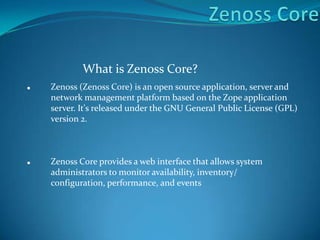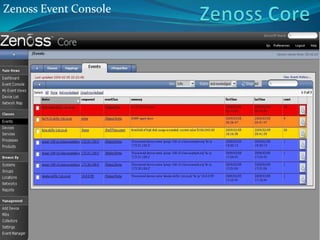Zenoss seminar
- 1. Seminar On ZENOSS CORE (Network Monitoring Tool) Praful Bhosale MCA2 SEM –III KIT IMER’s MCA Dept. Date:-14-09-2013
- 2. What is Zenoss Core? Zenoss (Zenoss Core) is an open source application, server and network management platform based on the Zope application server. It's released under the GNU General Public License (GPL) version 2. Zenoss Core provides a web interface that allows system administrators to monitor availability, inventory/ configuration, performance, and events
- 3. Why Zenoss Core? Open Source Monitoring Solution More features including WMI performance monitoring Powerful plugins (ZenPacks)
- 4. What Technologies used in Zenoss? Zope :-Application server: An object-oriented web server written in Python. Python:-Extensible programming language. Net-SNMP-: Monitoring protocol that collects systems status information. RRDtool:- Graph and log time series data. MySQL:- A popular open source database. Twisted:- An event-driven networking engine written in Python.
- 5. What Zenoss Core can do? Monitoring availability of network devices using SNMP, SSH, WMI Monitoring of network services (HTTP, POP3, NNTP, SNMP, FTP) Monitoring of host resources (processor, disk usage) on most network operating systems. Time-series performance monitoring of devices Extended Microsoft Windows monitoring via Windows Management Instrumentation using Zenoss open source extensions Event management tools to annotate system alerts Automatically discovers network resources and changes in network configuration Alerting system provides notifications based on rule sets and on-call calendars
- 7. Zenoss Architecture User layer Zenoss Core is flexible enough to work from a command line, but most of our work will take place via a web interface, which is based on the Zope application server framework. Zope is a popular, extensible application server written in Python. It features a built-in web server, transactional object database, and HTML templates. Python is the basis for Zope; it's also the basis for Zenoss Core.
- 8. Zenoss Architecture Data layer RRD:- stores time series performance data CMDB:- managing the configuration, relationship, and change history of the IT environment, which creates a detailed model of the network
- 9. Collection layer Zope Architecture The collection layer includes several daemons that gather information about devices, performance, and Events. They feed information to ZenHub to distribute to the appropriate database. The Zenoss Core daemons are easy to identify—they all start with the prefix "zen".
- 11. Daemon It is a computer program that runs as a background process, rather than being under the direct control of an interactive user Device management daemons:- zenmodeler, zendisc. Performance and availability daemons:- zenperfsnmp,zencommand, Zenprocess,zenping,zenstatus. Event daemons:- Zensyslog,zeneventlog,zentrap.
- 12. Zenoss Core Installation 1. visit www.zenoss.com/download. 2. find native packages, stack installers, and source files for several operating systems:- Red Hat Enterprise Linux, Centos, Ubuntu, Fedora Core, OS X, OpenSuse, and Debian.,Windows. 3. Preparing devices for monitoring 4. Configuring SNMP and WMI 5. Configuring firewall
- 13. Setting up users
- 15. Specify or discover devices to monitor Adding devices
- 17. Zenoss Dashboard
- 20. Zenoss Performance & Reports
- 21. Zenoss is a good choice for open source network and systems management. The Zenoss system provides full stack coverage of networks, servers, applications, services, and virtualization. Conclusions
- 22. References 1) www.zenoss.com 2) en.wikipedia.org/wiki/Zenoss 3) Zenoss Core Network and System Monitoring by Michael Badger























